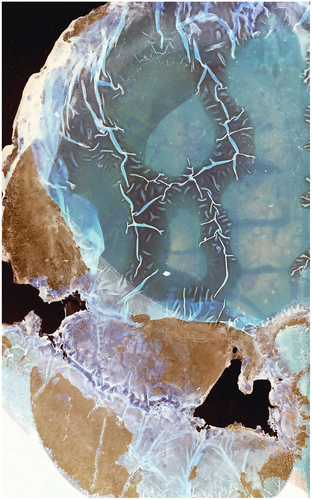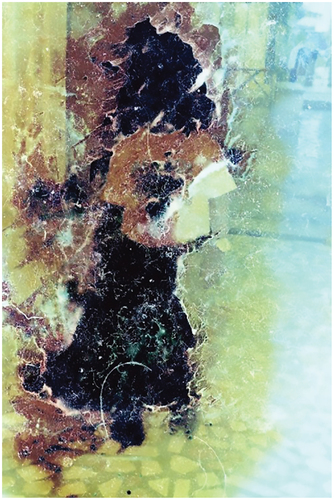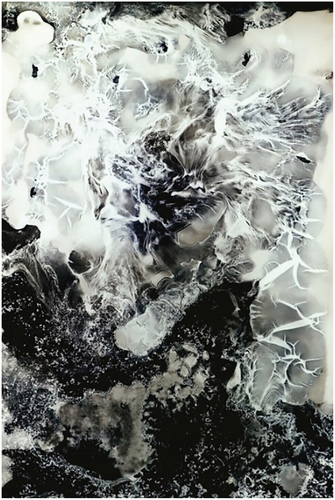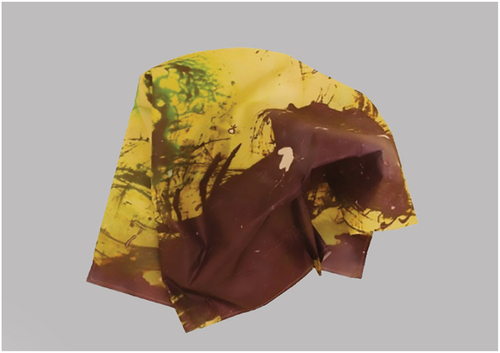Abstract
This paper explores the indexicality and materiality of the photographic medium, precisely the analog type, to examine the reality of the photographic image. It is praxis and a study that seeks to keep alive the obsoleteness of analog photography. It discusses the photograph as an image and an object to determine the medium’s nature and ascertain whether it simply represents actual states of things or events above all other art representation forms. Old photographic films or negatives were found and collected from commercial photography studios. These films were subjected to unorthodox chemical processes to observe and experiment for outcomes. The study also traced some reality claims about the photograph and contesting arguments establishing paradoxical concerns about the medium. Through a series of questions and the studio-based experimentations in the gaze of progressing contemporary art practices, possible and alternative claims are artistically and metaphorically interpreted. The study outcome integrates the concept of sculpture as a presentational form.
PUBLIC INTEREST STATEMENT
The paper uses experimental methods to discuss the nature of photographs. It explores old negative film usually made from analog cameras for inquiry and creation of non-conventional images and forms. The study investigates the assumption of photographs representing reality literally. It also discusses counter arguments and nature of the medium as mythical. Mythical in the sense that the processes of the camera as a tool and how it represents events and objects are alien to what is photographed. The issue and artistic interest is developed from a subjective point of view resulting from the obsoleteness of analog photographic practices and the defunct nature of studios in Ghana and relatively in the world.
1. Introduction: “The reality show”
Predominantly, the notion of the photograph establishes itself as a medium that depicts reality or represents the actual state of things and events since its inception in the 1800s. Photographs are visual codes and an enterprise that seems to give the world an experience of a place that one has been to or desires to be. With the camera, a sense of appropriation is established about people, things, and events as one looks at photographs (Sontag, Citation2001).
In any part of the world, photographs serve as documentary records. They express the history, art, and culture of life itself. Hebert and Doran (as cited in Agyenim-Boateng, Citation2009) point out that to research and understand the history and culture of Africa, one has to study photographic archives of the country. For example, the Basel Mission photo archives in Ghana contain photographs that date back to the 1860s. Missionaries took these photographs that now serve as visual proof of the activities of the Basel Mission on the African continent. The photographs help viewers to understand past conditions and also serve as proof of support for their missionary work.
The usage and making of the photograph were fundamental during the colonial period. Pictures of pioneer photographer and studio owner James Koblah Bruce Vanderpuije share history, and a sneak peek into the lifestyles of the early 1900ʹs through to the mid-seasons of the century. The pictures are portraits of families and groups of the British, Indian traders, and black aristocracy (GreenViews, Citation2020).
A similar case study indicates how Eugene Atget made documentary images of Paris in the late 1880s for illustrators, theatrical designers, and architects with no aesthetic significance yet utilitarian. Interest in his images was in information, content, and detail (Edwards, Citation2006). His photograph of Saint-Andre’ des Arts depicts a street photograph, angled up to show an entire block. The photograph served as an indexical document, recorded to preserve an accurate account of the streets before the camera. It interprets a city abandoned and existing in an historic time in Paris (Hughes, Citation2017).
Suffice to say, the photography practice of photographers (past and even present) serves as a window to the past while presenting realistic images to viewers. The hallmark, training, and influences of fore practitioners encouraged the establishment of numerous studios and labs, with a focus on processing or developing negative films with chemicals until the late 20th century when digital photography made analog photography practices redundant. The lack and ineffectiveness of these labs as observed in Ghana and relatively around the world is of interest in this study to memorize and revive attention to the medium. Photographs created by pioneers and the various labs that sprung up generally read photographs as realistic. The emergence of the medium and how it represents images truthfully attributes high credence to photographs than any other artistic representation mediums and forms, i.e., painting, sculpture, drawing, etc. The realistic reading of photographic images is arguably ascertained.
According to Bazin and Gray (Citation1960, 4–9), the photographic image is verisimilitude to objects photographed and not an approximation, “the photographic image is the object itself.” No matter how fuzzy, distorted, or discolored, no matter how lacking in documentary value an image may be, it shares by the very process of becoming the being of the model, even if it is the reproduction.
Bazin’s account of the photographic image blurs distinctions between the object photographed and the picture that represents the referent; it advocates every image as the object and the object as an image. The potency ascribed to the photograph makes it a preferred medium satisfying the immortalization of individuals and events in time. The photograph’s reality claim interestingly reflects the reincarnation concept of Tibetans. For Tibet, photographs are more than a “certificate of a presence” culturally. The indexical link of the photograph enacts relationships of the past, present, and future. In the reincarnation concept, Tibetans place immense value on the photograph and according to their beliefs, the human body equates to a receptacle that is occupied by a person. In consequence, when one understands photographs in sensory and haptic registers, i.e., things, objects, and material that can be touched or sensually experienced, then it incarnates a person to present experiences without the need of the individual or space bodily (Elizabeth & Hart, Citation2004). The photograph, in this case, is the person, whether dead or alive in Tibet.
The credibility of the photograph, who and what it represents realistically, is very much realized during funeral ceremonies. Many families display images of their lost ones, look on, and moan as they mourn the demise of their loved ones. The photograph assumes the power to trigger intense and sorrowful emotions.
Bazin’s view on the nature of the photographic image identifies with the ideas of Walton and Hopkins, both labeling their claims on photographs as transparent and facts, respectively (Walton, Citation1984).
On the contrary, Barthes (in Camera Lucida) states that the photograph is always “invisible” and that it is not the image that one sees, no matter what it grants to vision. No matter what a photograph depicts, in whatever manner, “it is not the object that we see.” Photographs, in essence, conceive a sign without a mark, or it is a signifier without a signified in semiotic terms (Barthes, Citation1981, 6–7). This implies that often one looks at the reference but not the photograph. This is illustrated by interpretations that say, “this is me” when showing someone a photographic image of oneself as opposed to “this is a picture of me” (Houlihan, Citation2004). The photograph from Barthes’s deduction becomes “dead” to begin a representation in the first place.
For Benovsky (Citation2011), the photographic image is not real and by extension non-transparent because of the various mechanical and human interventions that the production processes of photographs go through. The necessary decisions in a schema of focal length, aperture, shutter speed, chemical conditions, temperature, material behavior, human decision and interventions, and so on, prevent photographs from being accurate and transparent. The process of photograph production is never purely mechanical. He argues a photographic system is a creative tool (just like the painter’s brush) that by its processes, obliges photographers to make creative choices that have a strong impact on the resulting image.
Sontag (Citation2001) asserts that photographic images are fragments of truth, alienating the viewer from the whole and establishing limitations to the medium as realistic. For her photography seemly certify experience, yet “taking photographs is also a way of refusing it. It limits the experience to a search for the photogenic, by converting experience into an image.” The sentence it implies photographs are not absolute representation of the real should not be in quotation marks.
These arguments raised on the reading of the photographic image beyond reality critically generate tension and paradoxes on the nature of the photographic image.
Therefore, this study, as stated by Batchen (as cited in Elizabeth & Hart, Citation2004) in appreciation of photographs beyond visual contents, permits the praxis to dual read the medium as an image and an object. It probes: how does photography represent reality? What is photography, what is a photograph, and what can it become? How can the image be experienced as an intrinsic material, something beyond the documentary or representation of literal reality?
The inquiry is inspired by contemporary approaches as it seeks to expand the knowledge and conversation on photography practices by altering the conventional aesthetics that is very well known among significant photographers in Ghana and similar worlds, i.e., documentary photography.
1.1. When Photography Becomes Photograph
It is enlightening that photographs are realistic as mostly perceived due to the camera’s technological abilities and chemical processing component. Photographs seemingly have the upper hand over all real image making forms; however, the problem is that it is most often considered as a mere image or a purely visual medium (Photography’s New Materiality). We often read what photographs present to us and not how they represent things. The photograph as a strictly visual medium has generated most of the realistic claims. However, this study identifies counterarguments and observations. The exploration in this study privileges the photograph as a material site. An object whose physicality can be intervened, manipulated, and transformed to complement the examination to determine what is and what can become of the photograph.
According to Bourriaud (Citation2002), using objects necessitates interpretation, and using products betrays concepts. In post-production theories and practice, it is keen to give new utterances to things or reuse things to articulate new forms and ideas than represent the end result of anything. Contemporary work of art ceases to be endpoints of creative processes or finished product but a gateway to generate activities endlessly. For instance, music DJs envision, unfold, and evoke the history of music, by copying and pasting together loops of sounds, and placing recorded products in relation to each other to produce new cartographies of knowledge. Raymond Hain’s reuse of found torn posters to create hyper graphics and readymade painting typifies post-production processes (MACBA, Citation1999).
Post-production practices make it understandable to recognize that what matters is what to make with elements placed at our disposal, as it is no longer a matter of elaborating a form based on raw material, but working with objects that are already in circulation on the cultural market. Additionally, the post-production concept demonstrates that images are tangible actors that can be used to convey meaning.
2. Materials and Methods
The study is practice-based research through studio acts and practices. It employed metaphoric representations as reflective practice to experiment, observe, and interpret meanings, and explore forms and practice (Doloughan, Citation2002). Exploration and investigation into the medium emerged as an “affect.” It thrives on subjective feelings and modest offerings of materials. Interest is given to the interactive potentialities of the material media (Smith, Citation2011, 256).
Practically, the study was formulated by observing the photography landscape in Ghana to identify the problem of defunct studios and institutions as they offered no services in analog photo productions. The medium is obsolete to Ghanaians and relatively to the world. The order of photo practice is essentially digital; therefore, the interest is to salvage the practice of analog photography to investigate the foundations of the medium.
In initial studio experiments, a landscape scene (Figure ) was captured with the camera using colored films and then developed with black and white chemicals to produce subtle or counter pictures that triggered questions like, what is photography? What is a photograph? How does it represent the truth? And what can it become? These questions emerged due to the photograph becoming seemingly shadow representations of the scene photographed. During the experiment, necessary conditions and situational intervention affected the outcome of the image (Benovsky, Citation2011). Theoretically, the study relied on the various texts that read photographs as realistic, fact, and transparent (Bazin & Gray, Citation1960; Hopkins, Citation2010; Walton, Citation1984) but also invisible, non-transparent, and fragments (Barthe 1980; Walton, Citation1984; Sontag 2005). These readings place the medium in paradox; it indicates limitations and probable natures of photographs. The complexity of reading photographs oscillates between visibility and invisibility. Thus, the “field of photographic discourse resembles a panicked crowd.”
Metaphorically, the study interprets these tensions in the medium by prioritizing the image object form of photographs for meaning-making (Elizabeth & Hart, Citation2004). In the study, old and already exposed negatives were further collected and factored as materials to explore, to intervene in, and experiment with (Figure ). The negatives were considered charged with “mise-en scenes” because they were documented negatives with images on them, however, an object also. The negatives (image/object) were subjected to tests with unorthodox chemicals. Chemicals used included sulphuric acid, caustic soda, and kerosene. Over time, the gelatin emulsions and the plastic rubber reacted to the corrosive chemicals to evoke the materiality of the negative film (Figure ). The resultant effect of the reaction was scanned, printed, and manipulated for exhibition.
In the symbolic test, images meet objects to create amorphous image with fragments of supposed reality lurking in the post-produced image (Figure ). The act of subjecting these films to the chemicals symbolized the idea of testing the (Figure ) reality claim of the photograph. As a point of departure (Figure ), some material forms of the new image are oddly pushed further to take the form of sculptures in an organic character due to the arbitrariness and amorphousness of the latest images. In creating the soft sculptural forms, needles and thread were used to stitch the fabric print to suggest the 3D relief forms (Figure ).
3. Results
The study ascertains by studio art and argumentative text that the photograph is not simply a representational medium to conclude its reality extensively. Because it does not exist only as a visual form but also as an object dwelling in space and time. It has potential and inherent physical qualities to read from and explore. The implication of the multiple readings is reflective on the studio praxis. The complex outcome of the experiments executed in this study proves the tensions that are inherent in looking at photographs. The new images (Figures ,and 5) influenced by the concept of post-production reference the claims of invisibility by Roland Barthes and photograph-sharing fragments of the subject by Susan Sontag. Figures , for instance, suggest the presence of subjects in the photographs, however the materiality of the negative film after experimentation denies the accuracy of the subject and its visibility. Critical observation indicates how the material behavior of negative film allows gelatin emulsion and its plastic form to melt and stain over the subject, i.e., image meets object to interpret the photograph. The extreme of invisibility as suggested by Barthe is typical in Figure . The materiality of the photograph takes over the subject in the photograph and for that matter, the photographed subject is not seen. The study as argued by Benovsky clarifies how interventional approaches and various necessary conditions like the materiality of the negative film influence the making of photographs. The processes take away truthfulness or reality from observers, and for that matter, the need to reconsider the state of existence of the photograph suggests to viewers beyond all representation forms in art.
4. Discussions
According to Greenberg (Citation2018), it is ideal to “use the characteristic method of a discipline to criticize the discipline itself, not to subvert it but to entrench it more firmly in its area of competence”. The realistic appeal that photographs suggest to viewers should not conceal other character traits of the medium. Traditionally, photographs are papers with inks on them that are precisely and mechanically formed, similar to paints from tubes applied on a canvas. Critical examinations determine whether reality with the photographic image is pseudo or psycho reality. Photographs only give the impression of fact, it appeals to the mind to suggest an internal trust to viewers, either consciously or unconsciously, and expect observers to receive its representation as accurate. Photographic representation is a myth. The pseudo/psycho reality of the photograph presupposes that such representations can be achieved with other art representation forms. For example, realistic paintings, drawings, and sculptures undeniably give viewers a representation of a person or activity even though they may not be in ideal characteristics of the subject matter.
The question what is photography? is determined in this study as ephemeral. Ephemeral in the sense that the process of making most images happen in a split of seconds. Photograph in context is the diverse iconographic materialization of photography, and for that matter, it can become arbitrary stains, ghost pictures, invisible pictures, and sculptures. The studio act sacrificed verisimilitude or correctness to enact the painterly and material characteristics of photographs for necessary understanding. Concerning the form, the study notes that photographs are or can be sculptures artistically.
The examination and experiment stretch the curiosity in appreciating any practice in art, be it painting, sculpture, drawing, and so on. The pervasive quest and intent to concentrate on artistic representation can be reimagined to accommodate alternative readings to push boundaries of what a particular artform could mean and how it can be presented. Prioritizing material media and wholeness of an art form are approaches for reinventions, interventions, integration, and gateways for challenging status quo. The argument of Roland Barthe, for instance, is implicit in reading and rereading any artistic representation. For example, the materials used for canvas painting or sculpture and the form it is presented are essential determinants for meaning making.
5. Conclusion
“I have pitched everything I can against death to create something more hopeful; it is gone but not forgotten” (Randhawa, Citation2014). Damien Hirst's citation illustrates the fact that, despite analog photography being out of date, this study hopes to resurrect practices and debate surrounding it. The study is potent to sensitize the need to revisit the medium’s foundation and inspire the interest of art institutions and practitioners, especially in Ghana, to revive or create photo labs that can foster photography practices beyond the documentary.
It examined the nature or idea of the photographic image representing reality literally. In response to the realistic claim, it reviewed opposing arguments from Jiri Benovsky, Susan Sontag, and Roland Barthes. It situated complexities and paradoxes to think of regarding the photographic image. Studio practices explored the image object phenomenon to recognize these complexities, which are visually and metaphorically interpreted, leading to the kind of photo works produced. The study utilized old negative films as a material for exploration, interpretation, and understanding. The methodology for identifying paradoxical reading of the medium is experimental and not in its entirety philosophical. The praxis stretches the flat surface or two-dimensional presentational forms of photographs to three-dimensional forms to foster the integration of multidisciplinary concepts of art for interpretations. The artistic exploration is an essential cue for unique interventions for non-conventional practices of the medium least to Ghanaian photographic practitioners.
The study ascertains the claims of Jiri, Susan, and Barthes, and reveals the mythical nature of the medium. The post-produced images (Figures ) and forms are expressions that are alien to the mis en scenes of the old negatives used. The images reform into arbitrary stains, and color patches with ghost images lurking in some of them. The traditional flat representational forms reform to organic sculptural forms (Figures ) that are false to photo conventions.
Acknowledgements
Many thanks to the Department of Painting and Sculpture, Knust, for allowing us to use their studios for the practical component of this study. We also acknowledge the effort of Anita Tofah in editing the text. Our thanks also go to the various photo labs that made their Negative films available for this study.
Disclosure statement
The authors have not declared any conflict of interest.
Additional information
Funding
Notes on contributors
Ebenezer Mensah
Ebenezer Mensah I am an art enthusiast, and Assistant Lecturer at Ho Technical University – Ghana. I currently hold an MFA degree in Painting and Sculpture from Kwame Nkrumah University of Science and Technology, Ghana. My research interest is in Art Philosophy, Art History, Sculpture, Photography, and Contemporary approaches to visual art design and practice.
Junior Ansah-Asiedu
Junior Ansah-Asiedu I currently work as an Assistant Lecturer and a Graphic Designer at the Department of Industrial Art-Ho Technical University. My research interest is in Product Design Technology, 2D Computer Graphics, and Digital Illustration. I hold an MPhil degree in Product Design Technology from Kwame Nkrumah University of Science and Technology.
Samuel Kwame
Samuel Kwame
I am Samuel Kwame, a Graphic Design Lecturer at Ho Technical University, Ghana. Over the past decade, I have handled courses such as 3D Computer Graphics, Photography, Digital Painting, Digital Illustration, and so on. My research areas are 2D and 3D Computer Graphics, 3D printing, Photography, and Interactive Design of teaching in Arts and Design.
Charles Vicku
Charles Vicku
I am an academic and Assistant Lecturer at the Department of Industrial Art, Ho Technical University. My research interest is in Conceptual art, Ceramic building materials, and Product design.
References
- Afrik, D. 2021. “CELEBRATION OF FEMALE PHOTOGRAPHER PIONEER IN GHANA FELICIA ABBAN. DEBONAIR AFRIK. https://debonairafrik.com/celebration-of-female-photographer-pioneer-in-ghana-felicia-abban/
- Agyenim-Boateng, P. 2009. “PHOTOGRAPHY IN GHANA: ITS EFFECTS ON CULTURE AND TOURISM.” Duraspace. http://dspace.knust.edu.gh/handle/123456789/456
- Barthes, R. (1981). Camera Lucida_Reflections_on_Phoyography. Translated by Richard Howard. Macmillan.
- Bazin, A., & Gray, H. (1960). The Ontology of the Photographic Image. Film Quarterly (JSTOR), 13(4), 4–11. https://doi.org/10.2307/1210183
- Benovsky, J. (2011). Three Kinds of Realism About Photographs. The Journal of Speculative Philosophy, 25(4), 375–395. Accessed January 25, 2018 http://www.jstor.org/stable/10.5325/jspecphil.25.4.0375
- Bourriaud, N. 2002. Postproduction. Edited by C. Schneider. Lukas & Sternberg. Accessed May 30, 2018.
- Dickenson-Bampton, B. 2017. “Wolfgang Tillmans 2017” In Review. Tate Modern,United Kingdom. Accessed February 13, 2018. https://www.lensculture.com/articles/tate-modern-wolfgang-tillmans-2017-in-review
- Doloughan, F. J. (2002). The Language of Reflective Practice in Art and Design. Design Issues, 18(2), 57–64. https://doi.org/10.1162/074793602317355783
- Edwards, S. (2006). Photography A Very Short Introduction. Oxford University Press. Accessed December 12, 2017.
- Elizabeth, E., & Hart, J. (2004). Photographs objects histories: On the materiality of images. Routledge. Accessed May 7, 2018.
- Greenberg, C. (2018). Modernist painting. In F. Francis, & C. Harrison (Eds.), Modern art and modernism: A critical anthology (pp. 5–10). Routledge.
- GreenViews. 2020. “Deo Gratias Photo Studio, a treasure in the “ruins” of Jamestown.” March 16. Accessed June 14, 2021. https://greenviewsresidential.com/ghana-deo-gratias-photo-studio/
- Hopkins, R. (2010). Factive Pictorial Experience: What’s Special about Photographs? Noûs, 46(4), 709–731. https://doi.org/10.1111/j.1468-0068.2010.00800.x
- Houlihan, K. 2004. “Roland BArthes’ Camera Lucida- Reflection on Photography annotation by Kasia Houlihan.” Theories of Media. The University of Chicago. Accessed June 14, 2018. http://csmt.uchicago.edu/annotations/barthescamera.htm
- Hughes, S., 2017. Eugene Atget, photographer of Paris. Sabrina Hughes | PHOTOXO LLC. http://photoxo.net/2017/01/18/eugene-atget-photographer-of-paris/
- MACBA. 1999. “Raymond Hains, EXHIBITION.” September 30. Accessed June 6, 2018. https://www.macba.cat/en/exhibition-raymond-hains
- Plummer, S., Riches, H., & Duncan, W. nd. “Photography’s New Materiality: An Intoduction.” National Media MuseumUK. Accessed June 6, 2018. http://eitherand.org/photographys-new-materiality/photographys-new-materiality/
- Randhawa, S. 2014. “Damien Hirst donates a gold plated mammoth skeleton for charity.” Luxury Launches. May 21. LUXURYLAUNCHES. Accessed August 9, 2021. https://luxurylaunches.com/other_stuff/damien-hirst-donates-a-gold-plated-mammoth-skeleton-for-charity.php
- Smith, T. (2011). Contemporary Art, World currents. 1st . Laurence King Publishing. Accessed July 18, 2021.
- Sontag, S. (2001). On Photography. 1st. RosettaBooks LLC.
- Walton, K. L. 1984. Transparent Pictures: On the Nature of Photographic Realism. Critical enquiry.University of Chicago Press. https://doi.org/10.1086/448287.







